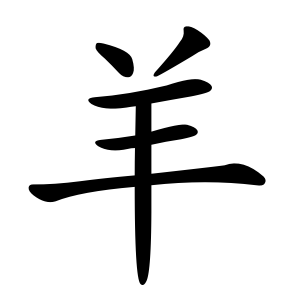Radical 123
Chinese character radical From Wikipedia, the free encyclopedia
Radical 123 or radical sheep (羊部) meaning "sheep" or "goat" is one of the 29 Kangxi radicals (214 radicals in total) composed of 6 strokes.
| 羊 | ||
|---|---|---|
| ||
| 羊 (U+7F8A) "sheep" | ||
| Pronunciations | ||
| Pinyin: | yáng | |
| Bopomofo: | ㄧㄤˊ | |
| Gwoyeu Romatzyh: | yang | |
| Wade–Giles: | yang2 | |
| Cantonese Yale: | yèuhng | |
| Jyutping: | joeng4 | |
| Japanese Kana: | ヨウ yō (on'yomi) ひつじ hitsuji (kun'yomi) | |
| Sino-Korean: | 양 yang | |
| Names | ||
| Chinese name(s): | (Left) 羊字旁 yángzìpáng (Top) 羊字頭/羊字头 yángzìtóu | |
| Japanese name(s): | 羊/ひつじ hitsuji (Left) 羊偏/ひつじへん hitsujihen | |
| Hangul: | 양 yang | |
| Stroke order animation | ||
 | ||
In the Kangxi Dictionary, there are 156 characters (out of 49,030) to be found under this radical.
羊 is also the 143rd indexing component in the Table of Indexing Chinese Character Components predominantly adopted by Simplified Chinese dictionaries published in mainland China, with ⺶ and 𦍌 being its associated indexing component.
Evolution
- Oracle bone script character
- Bronze script character
- Large seal script character
- Small seal script character
Derived characters
Sinogram
The radical is also used as an independent Chinese character. It is one of the Kyōiku kanji or Kanji taught in the third grade in Japan.[1]
See also
References
Literature
External links
Wikiwand - on
Seamless Wikipedia browsing. On steroids.




